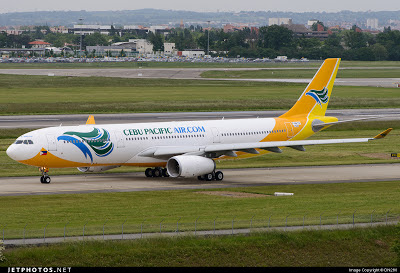Cebu Pacific Considering Wet Leases For USA Market
While the lifting of Category 2 status remains uncertain, Cebu Pacific is still keen on entering the US market. The airline previously announced that it would consider a wet-lease agreement with a foreign air carrier from a Category 1 country.
According to Alex Reyes, General Manager of Cebu Pacific's long haul division, the airline is still actively pursuing this option and looking for wet leases. If Category 2 is not lifted, the airline will be left with no choice but to enter into a wet lease agreement with another airline if it is determined to expand service to the United States.
Wet leases are different from dry leasing an aircraft as it involves leasing the aircraft as well as the crew. That means any flights on behalf of Cebu Pacific operated to the United States would be flown by a foreign crew. Cebu Pacific has already received clearance from the US Department of Transportation to serve all points in the United States with wet-leased aircraft. The airline expressed interest in serving the destinations of Honolulu, Guam, San Francisco, and Los Angeles.
The Philippines has been plagued by Category 2 status imposed by the US Federal Aviation Authority since 2008 for failure to comply with safety standards set by the International Civil Aviation Organization (ICAO). Being downgraded to Category 2 status has meant that Philippine air carriers are unable to expand beyond any existing service to the United States. Philippine Airlines has been restricted to just flying its two routes to Los Angeles and San Francisco with its fleet of Boeing 747 and Airbus A340 aircraft. The airline has wanted to expand its list of US destinations to include San Diego and New York in addition to utilizing its more fuel efficient Boeing 777 aircraft but Category 2 status prevents the airline from acting on those intentions.
As for Cebu Pacific, the airline had no existing service to the United States at the time the Philippines was downgraded meaning that it can't mount any flights to the US unless it enters into a wet lease agreement with a foreign airline. The good news is that the Philippines did successfully address the previous concerns of the ICAO in a recent audit that was conducted earlier this year. As the Philippines no longer remains one of the black listed countries with unresolved significant safety concerns, it is reasonable to expect that the FAA will return the Philippines to Category 1 status by the end of this year.
But the United States isn't the only country that imposed restrictions on Philippine carriers, the European Union blacklisted the country in 2010. It is hoped that the ban which prevents Philippine carriers from flying to destinations in Europe will also be lifted within the year. Both Korea and Japan also set restrictions preventing Philippine carriers from expanding service in the country.
The Civil Aviation Authority of the Philippines (CAAP) remains in a dispute with Japan who refuses to permit Philippine Airlines and Cebu Pacific from introducing new routes to other Japanese cities. According to CAAP Deputy Director General, John Andrews, Japan is making demands of the Philippines that is not within their purview to ask. The country is not recognizing the recent ICAO clearance to remove the Philippines from the blacklist. CAAP Director General William Hotchkiss was so insulted by Japan's behaviour that he wrote to President Aquino asking that the air treaty between the Philippines and Japan be abolished. Japan is not confirming the official reason for not lifting its ban but Andrews speculates that it could be economic. Once Philippine budget carriers expand their low fare service to more Japanese cities, that will increase competition and apply pressure on Japan's full service legacy carriers.
Meanwhile, Cebu Pacific is eagerly anticipating the launch of its long haul division with its first flight to Dubai in October. "We see no reason why the same dynamic can't apply to the long-haul market," says Reyes. "Our short haul operation is very successful. Long haul could be just as successful." The carrier just took delivery of its first long haul Airbus A330-300 aircraft which will be used on routes to Korea and Singapore. In September, a second A330 will arrive and that will be used on the Dubai route.
Low cost carriers now represent one out of every six seats on international routes from the Philippines. The Philippines has the highest concentration of low cost carriers in the entire world. "Even with all of the impressive economic growth the Philippines is experiencing today, income per person is below $3,000 per person. Only low cost carriers can make travel ultra affordable," said Reyes.
 |
| Copyright Photo: DN280/Jetphotos.net |
Wet leases are different from dry leasing an aircraft as it involves leasing the aircraft as well as the crew. That means any flights on behalf of Cebu Pacific operated to the United States would be flown by a foreign crew. Cebu Pacific has already received clearance from the US Department of Transportation to serve all points in the United States with wet-leased aircraft. The airline expressed interest in serving the destinations of Honolulu, Guam, San Francisco, and Los Angeles.
The Philippines has been plagued by Category 2 status imposed by the US Federal Aviation Authority since 2008 for failure to comply with safety standards set by the International Civil Aviation Organization (ICAO). Being downgraded to Category 2 status has meant that Philippine air carriers are unable to expand beyond any existing service to the United States. Philippine Airlines has been restricted to just flying its two routes to Los Angeles and San Francisco with its fleet of Boeing 747 and Airbus A340 aircraft. The airline has wanted to expand its list of US destinations to include San Diego and New York in addition to utilizing its more fuel efficient Boeing 777 aircraft but Category 2 status prevents the airline from acting on those intentions.
As for Cebu Pacific, the airline had no existing service to the United States at the time the Philippines was downgraded meaning that it can't mount any flights to the US unless it enters into a wet lease agreement with a foreign airline. The good news is that the Philippines did successfully address the previous concerns of the ICAO in a recent audit that was conducted earlier this year. As the Philippines no longer remains one of the black listed countries with unresolved significant safety concerns, it is reasonable to expect that the FAA will return the Philippines to Category 1 status by the end of this year.
But the United States isn't the only country that imposed restrictions on Philippine carriers, the European Union blacklisted the country in 2010. It is hoped that the ban which prevents Philippine carriers from flying to destinations in Europe will also be lifted within the year. Both Korea and Japan also set restrictions preventing Philippine carriers from expanding service in the country.
The Civil Aviation Authority of the Philippines (CAAP) remains in a dispute with Japan who refuses to permit Philippine Airlines and Cebu Pacific from introducing new routes to other Japanese cities. According to CAAP Deputy Director General, John Andrews, Japan is making demands of the Philippines that is not within their purview to ask. The country is not recognizing the recent ICAO clearance to remove the Philippines from the blacklist. CAAP Director General William Hotchkiss was so insulted by Japan's behaviour that he wrote to President Aquino asking that the air treaty between the Philippines and Japan be abolished. Japan is not confirming the official reason for not lifting its ban but Andrews speculates that it could be economic. Once Philippine budget carriers expand their low fare service to more Japanese cities, that will increase competition and apply pressure on Japan's full service legacy carriers.
 |
| Copyright Photo: Anna.Aero |
Low cost carriers now represent one out of every six seats on international routes from the Philippines. The Philippines has the highest concentration of low cost carriers in the entire world. "Even with all of the impressive economic growth the Philippines is experiencing today, income per person is below $3,000 per person. Only low cost carriers can make travel ultra affordable," said Reyes.







No comments